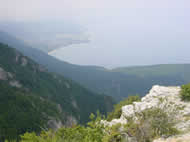|
  Lake Prespa Lake Prespa
Lake Prespa is the second largest natural lake in Macedonia. Situated at an altitude of 853 meters, it covers an area of 284 km2, sharing its borders with Greece and Albania. It lies in a tectonic valley, and like Lake Ohrid, it was formed in the Pliocene age. Lake Prespa is rich with 24 endemic taxa, 13 fish species, six of which are endemic. Due to its relative shallowness (its depth reaches only just over 50m), the lake can get quite warm, up to 25C degrees in the summer. Since 1995, Lake Prespa is included on the Ramsar List of Important Wetlands.
  Snake Island Snake Island
The Island of Golem Grad is also known as Snake Island due to all the water snakes that live around the shores of the island. The island is now uninhabited and is part of the natural reserve of Galicica National Park. The single-nave church of St. Peter, with fresco paintings dating back to the 14th century, can be found on the island. Archeologists have discovered remains of several other churches built here in the period between the 10th and the 14th centuries.
  Mt. Galicica Mt. Galicica
This mountain separates Lake Prespa from Lake Ohrid and it was declared a national park in 1958. It covers an area of 22,750 hectares. The highest peak is Galicica, which sits at an altitude of 2,275m above sea level. The mountain is very rich with fauna: bears, chamois, boars, deer, and several species of birds. There are around 130 species of trees and bushes, which is quite unusual for this part of Europe.
If you want to go from Lake Ohrid to Lake Prespa or vice versa you can take the 80-km-long road that goes through this mountain. The wonderful nature will definitely make everyone enjoy this ride, especially if you stop at the point overlooking both lakes, one to your left and the other on the right side. If nothing else, get to this spot just to enjoy the magnificent sunset reflecting in the water, on a warm summer evening. When taking this road, stop and visit the churches of St. Naum, St. Bogorodica, St. Stefan, or St. Ilija.
back |